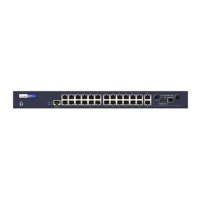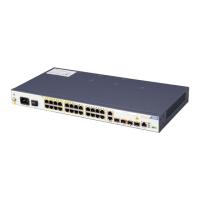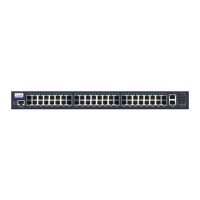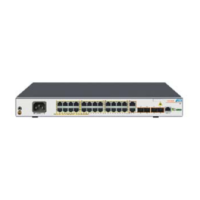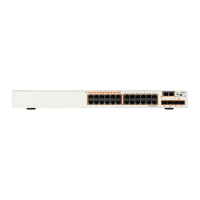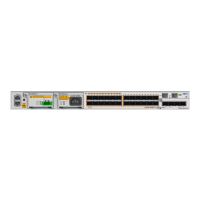
Do you have a question about the Zte ZXR10 2928E-PS and is the answer not in the manual?
Describes the intended purpose and scope of the manual for ZXR10 2900E series switches.
Outlines the chapters and their content included in the user manual.
Describes the different modes for configuring the ZXR10 2900E switch based on network connectivity.
Provides step-by-step instructions for configuring the switch via a console port using HyperTerminal.
Explains how to configure the switch remotely using a Telnet session.
Describes how to manage the switch using SNMP protocol via a network management server.
Details how to manage the switch remotely using a web browser.
Explains the different command modes used for switch configuration and management.
Describes the user mode, prompts, and basic commands like 'exit' and 'show'.
Explains how to enter global configuration mode using 'enable' and its password.
Details entering and exiting SNMP configuration mode for setting parameters.
Covers entering Layer 3 configuration mode for IP routing and ARP settings.
Explains entering file system configuration mode for managing FLASH memory.
Describes entering NAS configuration mode for access service management.
Details entering cluster management mode for configuring switch cluster services.
Explains entering basic ingress ACL configuration for rule management.
Covers entering extended ingress ACL configuration for managing ACL rules.
Details entering Layer 2 ingress ACL configuration for rule management.
Explains entering hybrid ingress ACL configuration for rule management.
Covers entering global ingress ACL configuration for rule management.
Details entering basic egress ACL configuration for rule management.
Explains entering extended egress ACL configuration for rule management.
Details entering Layer 2 egress ACL configuration for rule management.
Explains entering hybrid egress ACL configuration for rule management.
Describes entering Mac-Based-Vlan configuration mode for VLAN assignment based on MAC addresses.
Lists and describes common parameters used in switch commands for configuration.
Details how to use the command line interface, including online help features.
Explains how to use the '?' character for obtaining command and parameter information.
Explains how commands and keywords can be shortened for efficiency.
Describes the functionality for recalling and re-invoking previously entered commands.
Lists and explains the usage of various functional keys for user interface operations.
Covers operations related to the switch's FLASH memory, including version and configuration files.
Explains how to create, delete, and manage directories within the switch's file system.
Details operations for managing files, including renaming, copying, and viewing information.
Explains backing up and restoring version and configuration files using TFTP.
Covers backing up and restoring files using FTP, similar to TFTP operations.
Provides a caution and procedure for formatting the switch's flash memory.
Explains how to set up a TFTP server for backing up and restoring switch files.
Details the configuration of an FTP server, such as FileZilla Server, for file transfer operations.
Describes the process of importing and exporting switch configuration files for easy management.
Explains how to back up and recover switch configuration and version files from FLASH memory.
Covers the automatic download of software versions for undeployed devices via DHCP and TFTP.
Details the setup for automatically saving switch configurations to a TFTP server.
Provides instructions for performing software version upgrades on the switch, including normal and abnormal system states.
Explains how to check system hardware and software versions using the 'show version' command.
Provides a step-by-step guide for upgrading the switch version when the system is running normally.
Details the procedure for upgrading the switch version when the system is not starting normally.
Lists and explains commands related to file system operations like directory and file management.
Covers basic switch management configurations including mode switching and user access.
Details the configuration of switch ports, including auto-negotiation, duplex, rate, and line detection.
Explains Power over Ethernet (PoE) features, including port power supply and configuration.
Describes how to configure port mirroring for monitoring traffic on specific ports.
Covers Virtual Local Area Network (VLAN) configuration, including basic setup and tagged-based VLANs.
Explains operations related to the MAC address table, including learning, aging, and filtering.
Details Link Aggregation Control Protocol (LACP) configuration for increasing bandwidth and redundancy.
Covers IGMP Snooping configuration to optimize multicast traffic forwarding.
Explains MLD Snooping configuration for IPv6 multicast traffic management.
Provides configuration details for Internet Protocol Television (IPTV) services.
Covers Spanning Tree Protocol (STP), RSTP, and MSTP configuration for loop prevention.
Details Access Control List (ACL) configuration for packet filtering and security policies.
Explains Quality of Service (QoS) configuration for managing traffic and prioritizing services.
Covers Private VLAN (PVLAN) configuration for isolating users within a VLAN.
Describes configuring Layer 2 protocol transparent transmission for protocols like 802.1x and STP.
Details IPv4 Layer 3 configuration, including IP interface and static route setup.
Covers IPv6 Layer 3 functions for remote configuration and management.
Explains Dynamic ARP Inspection (DAI) for preventing ARP spoofing attacks.
Covers Network Access Service (NAS) using 802.1x and RADIUS for user authentication.
Details MAC-based authentication for devices that do not support 802.1x clients.
Explains QinQ (VLAN stacking) technology for extending VLANs.
Covers Syslog configuration for collecting and managing system log information.
Details Network Time Protocol (NTP) configuration for clock synchronization.
Explains Generic Attribute Registration Protocol (GARP) and GVRP configuration for VLAN distribution.
Covers DHCP configuration, including snooping and Option82 for secure IP address assignment.
Details DHCPv6 configuration for IPv6 host configuration.
Explains Virtual Broadband Access Server (VBAS) for wide-band user identifier solutions.
Covers PPPoE-PLUS (PPPoE+) technology for user location information.
Details ZTE Ethernet Smart Ring (ZESR) configuration for network reliability and fast fault convergence.
Explains Operation, Administration, and Maintenance (OAM) for Ethernet link management.
Covers SQinQ (VLAN tunnel technology) for transparent transportation.
Details VLAN mapping for converging customer and provider VLANs.
Explains sFlow configuration for monitoring high-speed data transmission networks.
Covers Protocol Protect (PP) for preventing attacks and ensuring network security.
Details Link Layer Discovery Protocol (LLDP) for neighbor discovery and topology information.
Explains single port loop detection to prevent broadcast storms and MAC table errors.
Covers UniDirectional Link Detection (UDLD) for detecting logical and physical link connectivity.
Details Terminal Access Controller Access-Control System Plus (TACACS+) for authentication, authorization, and accounting.
Explains configuring time ranges for specific access control policies.
Covers Voice VLAN configuration for prioritizing voice traffic.
Details IEEE 802.1ag for Connectivity Fault Management in virtual bridge LANs.
Explains Y.1731 protocol for measuring network link status and performance.
Covers MAC-based VLAN configuration for dynamic VLAN assignment.
Details DHCP Relay configuration for forwarding IP address requests.
Restricts network management access to specified IP addresses for enhanced security.
Covers Secure Shell (SSH) configuration for secure remote access and data encryption.
Explains privilege levels for controlling access to switch commands and configurations.
Details Simple Network Management Protocol (SNMP) for network monitoring and management.
Covers Remote Monitoring (RMON) for subnet behavior monitoring and statistics.
Explains ZTE Group Manage Protocol (ZGMP) for cluster management of switches.
Details sFlow configuration for monitoring high-speed data transmission networks.
Covers WEB management for remote switch configuration using a web browser.
Describes the M_button function for displaying key statistics and events via panel indicators.
Details Telnet configuration for remote Internet login service and switch operations.
Outlines daily and monthly maintenance tasks for ensuring switch operability.
Explains Virtual Line Detection (VCT) using TDR for line fault diagnosis.
Provides systematic troubleshooting steps for common hardware and software faults.
Troubleshooting steps for when console port configuration fails.
Analysis and handling for common issues causing Telnet connection failures.
Troubleshooting steps for when WEB management page cannot be accessed.
Procedure for recovering switch access when login credentials are lost.
Troubleshooting steps for issues preventing two devices in the same VLAN from interconnecting.
Diagnosing and resolving authentication timeout issues in a campus network environment.
Steps to mitigate ARP attacks affecting network access and switch performance.


